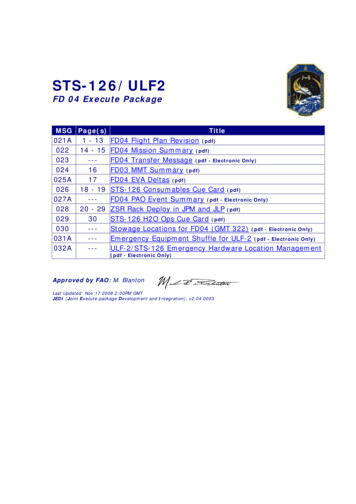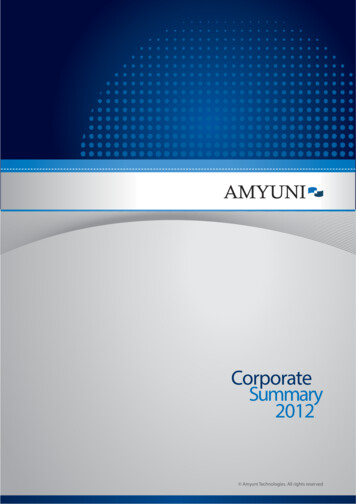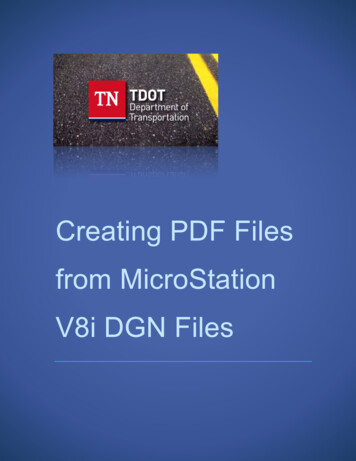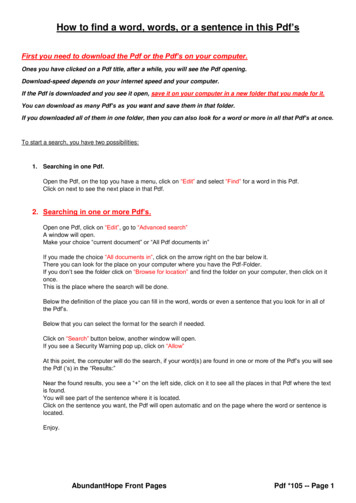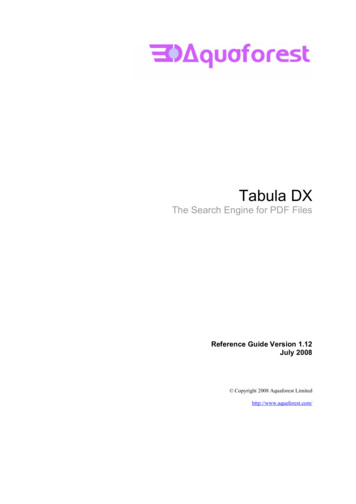
Transcription
Apago PDF Enhancer
TABLE 1.1Go vernment Ex pendi tures i n the Uni ted States, 1929–2008 (Billions of Dollars) aPERCENTAGE OF 11238.31382.71500.0FEDERALSTATE AND .9STATE %19.58%19.79%18.88%19.59%Apago PDF 9%30.10%30.17%29.87%28.91%30.17%Copyright 2010 Cengage Learning. All Rights Reserved. May not be copied, scanned, or duplicated, in whole or in part.
TABLE 1.1Co nti nuedPERCENTAGE OF 514264.6FEDERALSTATE AND 4608.74994.4STATE 2%21.53%22.76%Apago PDF 65%32.57%33.38%35.01%aCalendar years based on National Income and Product Accounts (NIPA) and current dollars for each year. Total government expenditure includesgovernment consumption and government gross investment. For 1929–1959 capital transfer payments and net purchases of nonproduced assetsare assumed to be zero.bExcludes federal grants-in-aid. State and local government expenditures are calculated as the difference between total government expendituresand federal government expenditures.Source: U.S. Department of Commerce, Bureau of Economics Analysis, www.bea.gov interactive NIPA historical tables with latest revisions as ofMarch 26, 2009.
TABLE 1.3Federal Go vernment Ex pendi ture by Functi o nFEDERAL EXPENDITURE 2008*HealthNational DefenseSocial Security and otherRetirement PensionsIncome SecurityNet InterestEducationPublic Order and SafetyHousing and CommunityServicesTransportationAll OtherTotalHousing andCommunity Services1.65%Public Order and Safety1.71%Education2.54%AMOUNT (BILLIONS OF DOLLARS)PERCENTAGE OF 61.15%6.35%100.00%Transportation1.15%All other6.35%Apago PDF EnhancerHealth24.99%Net Interest9.37%IncomeSecurity15.05%National Defense20.47%Social Security and otherRetirement Pensions16.73%*Based calendar year National Income and Product Account dataSource: National Income and Product Accounts, Interactive Tables, http://bea.gov
TABLE 1.4State and Lo cal Government current Expenditures byFuncti on * , 2008AMOUNTEXPENDITURE CATEGORY(BILLIONS OF DOLLARS)EducationHealthPublic Order and Safety (police, fireprotection, law courts, and prisons)Income SecurityTransportationInterest PaymentsRecreational and Cultural activitiesHousing and Community ServicesOtherTotalPERCENTAGE OF 99%100.00%Housing andCommunity Services0.58%Recreational and CulturalActivities1.40%Other10.99%Apago PDF EnhancerInterest ome Security7.45%Public Order and Safety(police, re protection,law courts, and prisons)13.03%Health20.21%*Includes expenditure financed by Federal Grants-in-AidSource: U.S. Department of Commerce, Bureau of Economics Analysis, Interactive Tables, http://bea.gov
Public FinanceA CONTEMPORARY APPLICATION OF THEORY TO POLICY, 10EApago PDF EnhancerDAVID N. HYMANNORTH CAROLINA STATE UNIVERSITYAustralia Brazil Japan Korea Mexico Singapore Spain United Kingdom United StatesCopyright 2010 Cengage Learning. All Rights Reserved. May not be copied, scanned, or duplicated, in whole or in part.
Public Finance: A ContemporaryApplication of Theory to Policy,Tenth EditionDavid N. HymanVP/Editorial Director: Jack CalhounPublisher: Joe SabatinoSenior Acquisition Editor: Steven ScobleSenior Developmental Editor: Julia ChaseEditorial Assistant: Lena MortisManufacturing Buyer: Sandra MilewskiAssociate Marketing Manager: Betty JungContent Project Manager: SathyabamaKumaran, Pre-PressPMG 2010, 2011 South-Western, Cengage LearningALL RIGHTS RESERVED. No part of this work covered by the copyrightherein may be reproduced, transmitted, stored or used in any formor by any means graphic, electronic, or mechanical, including but notlimited to photocopying, recording, scanning, digitizing, taping, Webdistribution, information networks, or information storage and retrievalsystems, except as permitted under Section 107 or 108 of the 1976United States Copyright Act, without the prior written permission ofthe publisher.For product information and technology assistance, contact us atCengage Learning Customer & Sales Support, 1-800-354-9706.For permission to use material from this text or product,submit all requests online at cengage.com/permissions.Further permissions questions can be emailed topermissionrequest@cengage.com.Media Editor: Deepak KumarProduction House/Compositor:Pre-PressPMGSenior Art Director: Michelle KunklerPermissions Acquisition Manager/Photo:Deanna EttingerLibrary of Congress Control Number: 2010922618ISBN-13: 978-0-538-75446-0ISBN-10: 0-538-75446-XPermissions Acquisition Manager/Text:Mardell Glinski SchultzCengage LearningApago South-WesternPDF EnhancerCover and Internal Designer: Rose AlcornCover Image: Artifan/Shutterstock5191 Natorp BoulevardMason, OH 45040USACengage Learning is a leading provider of customized learning solutionswith office locations around the globe, including Singapore, the UnitedKingdom, Australia, Mexico, Brazil, and Japan. Locate your local office atinternational.cengage.com/region.Cengage Learning products are represented in Canada byNelson Education, Ltd.For your course and learning solutions, visit academic.cengage.comPurchase any of our products at your local college store or at ourpreferred online store www.cengagebrain.com.Printed in the United States of America1 2 3 4 5 6 7 13 12 11 10
About the AuthorDavid N. Hyman, Professor of Economics and Alumni Distinguished Undergraduate Professor at North Carolina State University, has taught both undergraduate and graduate courses in public finance there since 1969. ProfessorHyman received his Ph.D. in Economics from Princeton University. He has heldWoodrow Wilson, Earhart, and Ford Foundation fellowships and was a Fulbrightsenior research scholar in Italy in 1980. From 1976 to 1977 he was visiting research professor at the University of Turin in Italy and in 1997 he was visitingprofessor of economics at the University of Ferrara in Italy. Professor Hyman is amember of the Academy of Outstanding Teachers at North Carolina State University and received the Alumni Association Outstanding Teacher Award in 1982 and1996. In 2006 he was a recipient of the North Carolina State University College ofManagement Teaching Excellence Award. In 2010 Professor Hyman was the College of Management recipient of the Board of Governors Award for Excellence inTeaching. He is the author of several widely used textbooks in economics and haspublished scholarly articles in the National Tax Journal, Public Choice, Journal ofEconomic Education, and other respected academic journals. In 2005 his PublicFinance text was translated into Chinese and published by the Peking UniversityPress. Professor Hyman served on the President’s Council of Economic Advisersas a consultant and as a senior staff economist from 1988 to 1989. He has alsobeen a guest scholar at the Brookings Institution and has worked as a governmentbudget analyst and as an economist for the Board of Governors of the FederalReserve System and the U.S. Comptroller of the Currency.Professor Hyman is also a photographer whose palladium and platinum printsare in the permanent collection of the Corcoran Gallery of Art in Washington,D.C. and the Gregg Museum of Art and Design at North Carolina State University. His photographs have been exhibited by galleries and museums in New York,North Carolina, California, and in China at the Pingyao International Photography Festival and in Beijing, and have been published in art books and on thecovers of several novels.Apago PDF Enhanceriii
PrefaceSince the last edition of Public Finance: A Contemporary Application ofTheory to Policy the U.S. economy has been buffeted by a major financialcrisis and the most severe recession since 1982. The recession has hadmajor impacts on public spending and revenue collection that has affected thebudgets of all levels of government. Even before the recession began it was clearthat major changes in the government sector were impacting public finance issues.Since 2001 the federal government’s share of the economy has been increasing, and there has been increased reliance on deficit finance. Federal expendituresfor both health care and national defense have been growing rapidly. The recession has resulted in extraordinary federal spending and tax cuts to stimulate aweakened economy and has contributed to increased government borrowing anda federal budget deficit of more than 10 percent of GDP. The economic downturnhas also had a major impact on state and local governments in the United States.As tax collections fell in 2008 and 2009 in response to reduced economic activity,states and cities have been forced to either cut spending or increase taxes to balance their budgets.The new edition of this book documents the accelerated growth of the government sector of the economy and its consequences. The fastest growing areaof government spending in recent years has been health care. The reform of thesystem of provision of health care in the United States has been a major issue in2009 and 2010. Government spending on health care has been increasing rapidly both on the federal and state levels. The new edition of this text continuesto discuss issues related to the provision of health care and the role of government in that sphere with an entire chapter devoted to the problems involved.The stimulus program enacted by Congress in 2009 also receives coverage inboth the expenditure and tax chapters. Fundamental controversies still rageabout how to deal with the Social Security system as the population ages. Therole of government in supporting education remains an important issue. Allthese perennial as well as newer government issues are covered in this 10th edition. There is a separate chapter on deficit financing by government. This unique feature focuses on the implications of government borrowing for theeconomy and is of major importance in view of the fact that the budget deficithas exploded in recent years and must eventually be brought down to avoidfuture negative consequences for the economy.The text retains its in-depth coverage of tax theory and policy issues. Sectionson taxation have been updated to discuss issues in tax reform and the impact ofApago PDF Enhanceriv
Prefacetaxes on incentives and economic growth. The latest data on tax rates and the distribution of tax burden are included.CHANGES IN THIS EDITIONThe 10th edition continues to provide comprehensive coverage of theoretical andapplied issues in public finance. The latest data are used to make sure all charts,tables, and analyses are timely and relevant. Many issues now receive expandedcoverage. For example, the discussion of the implications of aging populationsfor public finance has been enlarged and includes the latest United Nations projections of dependency ratios. International data on public finance has been updatedand there is more discussion of state and local government finance in the UnitedStates to reflect recent developments, particularly the impact of the recession onthe budgets of these governments. The analysis of environmental protection anduse of “Cap and Trade” programs to reduce emissions has been updated and expanded. The growing share of government spending and GDP going to nationaldefense and health care in the United States receives more analysis. Current dataon poverty and recent research on the impact of the U.S. system of assistance tothe poor (TANF) on incentives to work, welfare caseloads, and the well-beingof the needy is used to evaluate the impact of income support policies. The impactof the recession of 2007–2009 on TANF is also discussed. The impact of the recession on spending for the Supplemental Nutrition Assistance Program (SNAP—formerly called the Food Stamp Program) is also included. Issues relating togovernment provision of Social Security pensions and health care are discussedusing the latest data. In this new edition there is expanded coverage of the waySocial Security pension benefits are calculated for retirees, and there is more international analysis of the impact of growing old-age dependency ratios for publicfinance. There is also more discussion of possible reform of the Social Securitysystem. The discussion of government expenditures for health care has beenrevised. The analysis of the Medicaid program and its impact on state governmentbudgets has been updated and there is more analysis of the Medicare program aswell as that of extending health insurance coverage to the uninsured in the UnitedStates and the role of government in controlling the growth of health care spending. The impact of the American Recovery and Reinvestment Act of 2009 on theeconomy and state and local governments is also discussed.In the chapters on taxation recent data on the distribution of tax burden andtax rates are included. The tax provisions of the 2009 stimulus legislation enactedby Congress are also discussed. The long-term fiscal and economic implications ofgovernment budget deficits as well as trends in the use of borrowing as a means ofpublic finance receives expanded coverage. International analysis of budget deficits is expanded to include the implications of more foreign ownership of federaldebt and an extended example of the consequences of unbridled government deficits. Recent proposals for reforming income taxation in the United States are analyzed. Estimates of marginal and average tax rates for income taxation for 2009are presented along with recent estimates of the distribution of the federal taxApago PDF Enhancerv
viPrefaceburden for 2009. Statistics on corporate income taxes, sales taxes, property taxesand intergovernmental fiscal assistance statistics have been updated.SPECIAL FEATURES OF THIS BOOKIn addition to the boxed features on international issues and public policy, eachchapter also has pedagogical features such as learning objectives and conceptchecks.To facilitate learning, important concepts are set in colored bold type whenfirst introduced, and every chapter concludes with a summary, a list of importantconcepts, and a short “forward look” that explains the relationship between thechapter and those that follow. Also, each chapter includes questions for review.These questions are not problem sets; rather, they are designed to help studentsreview the material covered in the chapter by presenting questions related to itsmajor points or ideas. Several problems follow the review questions. Each chapteralso has an annotated bibliography offering suggestions for further reading andin-depth study. The bibliography should prove particularly useful in courses inwhich term papers are assigned. All chapters have references to Internet sites. Liberal use is made of footnotes throughout the book to provide additional sourcematerial and to explain and document material. A glossary at the end of thebook lists and defines all important concepts for easy reference.I have attempted to make this book as self-contained as possible; even students with only a minimal background in economics can use it. Appendixes to several chapters facilitate this process. For example, Chapter 1 includes an appendixthat can be used as a convenient reference tool for students unfamiliar with basicmicroeconomic theory. It features simple, concise explanations of concepts such asindifference curves, income and substitution effects, consumer surplus, producersurplus, cost, and production theory. Although the appendix is not designed ascourse material, it will help students understand, as well as review, the analysesused throughout the book.An appendix to Chapter 2 provides a more in-depth analysis of efficiencyusing Edgeworth box diagrams to derive efficiency loci. The appendix toChapter 11 derives formulas for the excess burden of taxation and addressesthe relevance of compensated demand and supply curves to tax analysis. Theappendices to Chapters 2 and 11 cover more advanced material and may beskipped without loss of continuity.Apago PDF EnhancerPOSSIBLE COURSE OUTLINESThis book contains more material than could possibly be covered in a onesemester (or one-quarter) course in public finance. Instructors of one-semestercourses will find enough material to adapt to their own needs and interests.Teachers of the two-semester sequence of the microeconomic aspects of publicfinance could cover Parts One and Two (the expenditure aspects of public finance)
Prefacein the first semester, and Parts Three, Four, and Five (government finance and fiscal federalism) in the second. Instructors of the macroeconomic aspects of publicfinance could supplement the material in the text with excerpts from one of themany excellent macroeconomic books available.I suggest four possible course outlines for a one-semester course, each outlinehaving its own emphasis. Instructors may adjust these outlines according to theirpreferences.Outline 1: Basic Principles of Public FinanceFor intermediate economics courses, with students who have had at least onecourse in basic microeconomic theory:1. Chapters 1–5: The economic basis for government activity. Efficiency, marketfailure, externalities, public goods, public choice, and political equilibrium.2. Chapters 10–12: Principles of government finance.3. Chapters 14–17: Application of tax theory to tax policy.4. Selections from Chapters 6–9 and 18: Topics in public policy or state andlocal finance, used as time permits and according to the instructor’s interests.Outline 2: The Functionsof Governmentand GovernmentApagoPDFEnhancerExpenditureFor courses focusing on public policy and government expenditure, with studentswho have had at least one course in economics:1. Parts One and Two: The economic basis of government activity and application of that theory to selected policy issues.2. Part Five: State and local government finance.Outline 3: Tax Theory and PolicyFor courses addressing taxation, with students who have had at least one course ineconomics:1. Chapters 1 and 2: The functions of government and the concept of efficiency.2. Chapters 10–17: Government finance, tax theory, and tax policy.Outline 4: Public PolicyFor courses in public affairs or public policy, with students who have had little orno background in economics:1. Chapters 1 and 2: Efficiency, markets, and the economic basis for government activity.vii
viiiPreface2. Selections from Chapters 3–5: As appropriate to subject emphasis and student background. Topics could include externalities, public goods, and political equilibrium.3. Selections from Chapters 6–9: Issues in public policy. The instructor maywish to omit some of the more advanced sections in these chapters.4. Chapter 10: Introduction to government finance.5. Selections from Chapters 11–17: Topics in tax policy, chosen according todepth of coverage.6. Selections from Chapter 18: Topics in fiscal federalism, chosen according tocourse objectives. More advanced sections could be omitted.ANCILLARY MATERIALSInstructor’s Manual/Test BankIn conjunction with Kevin Balsam, I have prepared a concise Instructor’s Manual/Test Bank for this 10th edition. The Instructor’s Manual includes instructionalobjectives, changes in this edition, chapter outlines, major points and lecture suggestions, and answers to text problems. The Test Bank for each chapter includestrue/false, multiple-choice, and essay questions. New questions have been addedto this edition. This ancillary is available on the Instructor Web site and Instructor’s Resource CD.Apago PDF EnhancerLecture Presentation in PowerPoint This text features a PowerPoint slide presentation that professors can use to savevaluable class preparation time. This supplement covers all the essential topicspresented in each chapter of the book, including graphs, tables, and examples.Slides are crisp, clear, and colorful. Instructors may adapt or add slides to customize their lectures. The slides are available on the Instructor Web site and Instructor’s Resource CD.Instructor’s Resource CDThe IRCD includes the Instructor’s Manual/Test Bank and PowerPoint slides.Textbook Support Web SiteVisit the support Web site for this textbook to find free Instructor and Student resources. Instructors can find the Instructor’s Manual/Test Bank, PowerPointslides, and an Errata section. Students can find economics applications questions,Internet resources, Flashcards, and an Errata section.
PrefaceEconomic ApplicationsEconomic applications include EconNews, EconDebates, and EconData featuresto deepen understanding of theoretical concepts through hands-on explorationand analysis of the latest economic news stories, policy debates, and data. Organized by topic and continually updated, EconApps are easy to integrate into theclassroom.InfoTrac College EditionInfoTrac College Edition is a fully searchable online university library containing complete articles and their images. Its database allows access to hundreds ofscholarly and popular publications—all reliable sources—including magazines,journals, encyclopedias, and newsletters.ACKNOWLEDGMENTSI am indebted to all of the reviewers of this edition and past edition. Their helpfulcomments have helped to guide each revision. They include: Lori Alden, CaliforniaState University–Sacramento; Samuel H. Baker, College of William and Mary;Charles L. Ballard, Michigan State University; Kevin Balsam, Hunter College;Donald N. Baum, Dwight Blood, Eric Fredland, Richard McHugh, David Orr,Craig Stubblebine, David Terkla, Temple University; Marcus Berliant, Universityof Rochester; Katherine Chalmers, Colorado State University; Yuval Cohen andVirginia Wilcox-Gok, Rutgers University; Robert Collinge, University of Texasat San Antonio; Joseph J. Cordes, George Washington University; EleanorD. Craig, University of Delaware; Steven Cuellar, Sonoma State University;F. Trenery Dolbear, Jr., Brandeis University; William E. Even, Miami University;Lon S. Felker, East Tennessee State University; Richard Fenner, Utica College;J. Fred Giertz, University of Illinois; Robert J. Gitter, Ohio Wesleyan University;Timothy J. Gronberg, Texas A&M University; Philip Grossman, St. Cloud StateUniversity; Mehdi Haririan, Bloomsburg University; Frederic Harris, Universityof Texas at Arlington; Roberto N. Ifill, Williams College; William Kamps, SouthDakota State University; Charles R. Knoeber and Alvin E. Headen, Jr., NorthCarolina State University; Janet Kohlhase, University of Houston; WojciechKopczuk, Columbia University; Charles G. Leathers, University of Alabama; BillLee, Saint Mary’s College; Jane H. Leuthold, University of Illinois at UrbanaChampaign; Dennis Leyden, University of North Carolina at Greensboro; StephenE. Lile, Western Kentucky University; Barry Love, Emory and Henry College;Randolph M. Lyon, University of Texas at Austin; James P. Marchand, Universityof California at Los Angeles; Robert C. McMahon, University of Southern Maine;Amlan Mitra, Purdue University at Calumet; Michael A. Nelson, Illinois StateUniversity.; Lloyd Orr, Indiana University; Patricia N. Pando, Houston BaptistUniversity; Michael T. Peddle, College of the Holy Cross; Thomas Pogue, University of Iowa; Paul Rothstein, Washington University at St. Louis; KathleenApago PDF Enhancerix
xPrefaceSegerson and Thomas Miceli, University of Connecticut; James K. Self, IndianaUniversity at Bloomington; Mark Showalter, Brigham Young University; John A.Sondey, South Dakota State University; Michael Spicer, Cleveland State University; Davis Taylor, University of Oregon; Wade L. Thomas and Sherry Wetchler,Ithaca College; John P. Tillman, University of Wisconsin-La Crosse; Gary M.Pecquet, Southwest Texas State University; Michael J. Wasylenko, SyracuseUniversity; James R. White, Hamilton College; Gary Wolfram, Hillsdale College;Michael Wolkoff, University of Rochester; George Zodrow, Rice University; andC. Kurt Zorn, Indiana University.Thanks also to Joseph Sabatino, Publisher; Steven Scoble, Senior AcquisitionsEditor; Julia Chase, Senior Development Editor; Jennifer Ziegler, Content ProjectManager; Lena Mortis, Editorial Assistant; Betty Jung, Associate MarketingManager; Suellen Ruttkay, Marketing Coordinator; Deepak Kumar, MediaEditor; Michelle Kunkler, Art Director; and Sandee Milewski, Senior Manufacturing Coordinator.David N. HymanRaleigh, North CarolinaApago PDF Enhancer
Brief ContentsPART 1CHAPTERCHAPTERCHAPTERCHAPTERCHAPTERTHE ECONOMIC BASIS FOR GOVERNMENTACTIVITY12345PART 2CHAPTERCHAPTERCHAPTERCHAPTERIndividuals and Government 2Efficiency, Markets, and Governments 55Externalities and Government Policy 98Public Goods 144Public Choice and the Political Process 176GOVERNMENT EXPENDITURES AND POLICYIN THE UNITED STATES: SELECTED ISSUES6789Cost-Benefit Analysis and Government Investments 226Government Subsidies and Income Support for the Poor 259Social Security and Social Insurance 311Government and Health Care 360PART 3ApagoPDF EnhancerFINANCINGGOVERNMENTEXPENDITURESCHAPTER 10CHAPTER 11CHAPTER 12Introduction to Government Finance 412Taxation, Prices, Efficiency, and the Distribution of Income 445Budget Balance and Government Debt 489PART 4TAXATION: THEORY AND 1617The Theory of Income Taxation 526Taxation of Personal Income in the United States 557Taxation of Corporate Income 612Taxes on Consumption and Sales 643Taxes on Wealth, Property, and Estates 674PART 5STATE AND LOCAL GOVERNMENT FINANCECHAPTER 18Fiscal Federalism and State and Local Government Finance 708Glossary 745Name Index 756Subject Index 760xi
ContentsPART 1THE ECONOMIC BASIS FOR GOVERNMENT ACTIVITY1CHAPTER 1Individuals and Government2Individuals, Society, and Government 4Governments and Political Institutions 5The Allocation of Resources between Governmentand Private Use 6The Mixed Economy, Markets, and Politics 8Government Expenditures in the United States 9International View How Much Government? The Share of GovernmentExpenditure in Modern Economies 16The Structure of State and Local Government Expenditure 19Financing Government Expenditure in the United States 21Market Failure and the Functions of Government: How MuchGovernment is Enough? 23Public PolicyPerspectiveThe State of State Government FinancesApagoPDFEnhancer2009–2010: The Impact of a Recession26Aging Populations: Implications for Public Finance 27Summary 32Internet Resources 34Appendix 1: Tools of Microeconomic Analysis 36CHAPTER 2Efficiency, Markets, and Governments55Positive and Normative Economics 56Normative Evaluation of Resource Use: The EfficiencyCri
Apago PDF Enhancer TABLE 1.4 State and Local Government current Expenditures by Function*,2008 EXPENDITURE CATEGORY AMOUNT (BILLIONS OF DOLLARS) PERCENTAGE OF TOTAL Education 708.8 35.19% Health 407.2 20.21% Public Order and Safety (police, fire protection, law





